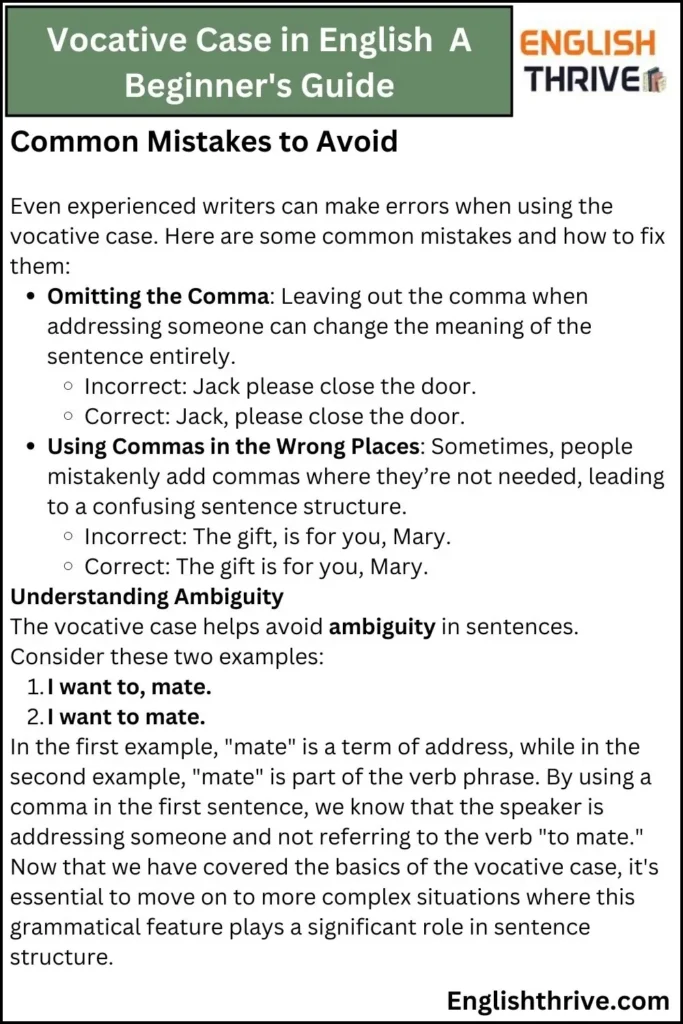The Vocative Case in English is an essential part of English grammar, but it is often misunderstood or overlooked by many learners. This article aims to offer a clear and engaging explanation of the vocative case, providing you with examples, key rules, and detailed explanations that will enhance your understanding of this important grammatical feature. Whether you’re a student or a professional, this guide will clarify when and how to use the vocative case correctly in your writing.
Contents
ToggleWhat Is the Vocative Case in English?
The vocative case is used when addressing someone directly in a sentence. It highlights the person (or thing) you are speaking to and helps to differentiate between the subject and the object in a sentence. In English, the vocative case is commonly marked by the use of commas or slight pauses in speech, signaling that the person being addressed is not part of the sentence structure but is the direct recipient of the statement.
Basic Characteristics of the Vocative Case
Direct Address: The vocative case is used to show direct communication. This could be speaking to a person, animal, or even an inanimate object.
Commas or Pauses: Words in the vocative case are typically set off by commas to separate them from the rest of the sentence. This helps avoid ambiguity and ensures clarity in the expression.
Example:
Hi, Sarah.
Jack, can you help me?
Without the comma, “Jack can you help me?” would imply a more general statement about Jack, instead of directly addressing him.
Examples of the Vocative Case in English
Simple Examples
Here are a few basic examples of sentences with the vocative case:
• Hello, James.
• Maria, please pass the salt.
• Look out, Tim!
In each case, the person being addressed is clearly marked by the comma, helping to convey that they are the direct recipient of the action or statement.
Real-Life Examples
The vocative case is most often used with proper nouns (specific names of people or things), but it can also be applied to common nouns and noun phrases.
• Susan, you’re amazing.
• Watch out, dog!
• Could you help me, dear friend?
Here, Susan and dog are both examples of direct address, and they help make the communication clear. Using the vocative case properly ensures that your message is directed specifically to the right person or thing.
The Vocative Case in Literature
The vocative case also appears frequently in literature, enhancing the emotional tone of dialogue or adding dramatic effect. A famous example is from Shakespeare:
• “O Romeo, Romeo! Wherefore art thou Romeo?”
In this iconic line from Romeo and Juliet, Juliet directly addresses Romeo, using his name to express her deep emotions.
The vocative case can also be used for animals or inanimate objects, demonstrating its versatility in English. Even though animals or objects cannot respond, the vocative case can express affection or command:
• Come here, Rover.
• Pick that up, chair!
These examples show how the vocative case goes beyond human names to address anything with which we interact.
Importance of the Vocative Case in English
The Vocative Case in English plays an important role in avoiding ambiguity in communication. Without the use of commas to set off the name or noun, sentences could be misinterpreted. Consider these examples:
I know Sarah.
This implies that the speaker is simply stating that they are familiar with someone named Sarah.I know, Sarah.
Here, the comma indicates that the speaker is directly addressing Sarah, perhaps to calm her down or agree with her.
Without the proper use of commas, it can be hard to tell if Sarah is the subject of the sentence or being spoken to. Thus, the vocative case is crucial in making our meaning clear.
The Role of Commas in the Vocative Case in English
One of the most distinguishing features of the vocative case in English is the use of commas. Commas are used to separate the person or thing being addressed from the rest of the sentence, creating clarity and enhancing readability. Here’s a deeper look at how commas function in the vocative case:
Before and After: If the name or noun is in the middle of the sentence, place commas both before and after it.
Example: Yes, John, you did it correctly.
At the Beginning or End: If the name or noun is at the beginning or end of the sentence, only one comma is necessary.
Example 1: John, you did it right.
Example 2: You did it right, John.
These subtle differences help ensure that the vocative case is used correctly and that the sentence flows smoothly.

Common Mistakes to Avoid
Even experienced writers can make errors when using the vocative case. Here are some common mistakes and how to fix them:
Omitting the Comma: Leaving out the comma when addressing someone can change the meaning of the sentence entirely.
Incorrect: Jack please close the door.
Correct: Jack, please close the door.
Using Commas in the Wrong Places: Sometimes, people mistakenly add commas where they’re not needed, leading to a confusing sentence structure.
Incorrect: The gift, is for you, Mary.
Correct: The gift is for you, Mary.
Understanding Ambiguity
The vocative case helps avoid ambiguity in sentences. Consider these two examples:
I want to, mate.
I want to mate.
In the first example, “mate” is a term of address, while in the second example, “mate” is part of the verb phrase. By using a comma in the first sentence, we know that the speaker is addressing someone and not referring to the verb “to mate.”
Now that we have covered the basics of the vocative case, it’s essential to move on to more complex situations where this grammatical feature plays a significant role in sentence structure.
How to Use the Vocative Case in English
1. The Vocative Case with Proper Nouns
The most common use of the vocative case is with proper nouns, which are specific names of people, places, or things. This usage directly addresses someone or something by name.
Examples:
Hey, Alex, come over here.
Mary, please call me when you arrive.
In these examples, the names “Alex” and “Mary” are directly addressed, signaling the vocative case. The commas around the names tell us that these words are not part of the main sentence structure but are instead meant to capture the attention of the person being addressed.
2. The Vocative Case with Common Nouns
Though less common, the vocative case can also apply to common nouns. This involves addressing an object, animal, or even a concept directly.
Examples:
Good morning, sunshine!
Come here, dog!
In these cases, the vocative case helps add personality or a tone of directness to the communication. It is particularly useful in informal speech or writing, such as when calling pets or addressing concepts in a poetic manner.
3. The Vocative Case in Phrasal Nouns
You can use the vocative case with noun phrases (groups of words functioning as a noun), where the noun phrase is directly addressed. In this case, the same rule applies: separate the address with commas.
Examples:
Well done, my little champion!
You did great, my dear friend.
Both “my little champion” and “my dear friend” are phrases that are being addressed directly. Commas are necessary to separate these phrases from the main body of the sentence and make the meaning clear.
4. The Placement of Commas
When using the vocative case, commas are critical for ensuring clarity and preventing ambiguity. There are specific guidelines for where to place commas depending on the position of the noun or noun phrase in the sentence:
a. Beginning of the Sentence:
If the vocative noun appears at the beginning of the sentence, place a comma after it.
Example: Anna, please close the door.
b. Middle of the Sentence:
If the vocative noun appears in the middle of the sentence, use commas before and after it to enclose it.
Example: Please, John, stop making that noise.
c. End of the Sentence:
If the vocative noun appears at the end of the sentence, place a comma before it.
Example: We need you to help us, Jack.
These rules help ensure that the sentence flows naturally and clearly conveys who or what is being addressed.
5. When Not to Use the Vocative Case in English
It is important to note that not every instance of a name or noun in a sentence requires the vocative case. For instance, when the name or noun is not directly addressed but is part of the sentence’s structure, you should not use a comma.
Example:
Jack and Mary are coming over for dinner.
Here, “Jack and Mary” are the subject of the sentence, not being directly addressed. Therefore, no commas are needed.
Why the Vocative Case Is Important
Understanding and using the vocative case correctly can greatly improve the clarity and precision of your writing or speech. The main functions of the vocative case include:
Preventing Ambiguity: Without the use of the vocative case, sentences could be confusing. For example:
I told Sarah you were here.
I told you, Sarah, you were here.
In the first sentence, it sounds as though the speaker told Sarah that someone was present. In the second sentence, it’s clear that Sarah is being directly addressed, and the meaning changes.
Expressing Tone: The vocative case is also essential for setting the tone of your message. Whether you are being affectionate, commanding, or informative, the way you address someone or something can completely alter the impact of your words. This is why the vocative case is so commonly used in dialogue and personal communication.
Avoiding Run-on Sentences: Incorrect punctuation with the vocative case can lead to run-on sentences, where two independent clauses are improperly joined together. The use of commas helps keep your sentences properly structured and easy to read.
Example of a Run-on Sentence:
I don’t like it John, it’s too sweet.
By using the vocative case correctly, you can make the sentence more grammatically sound:
I don’t like it, John. It’s too sweet.
Here, using commas separates the two independent clauses, avoiding the run-on error.
Conclusion On Vocative Case in English
The Vocative Case in English is a simple yet powerful tool in English grammar that can enhance both the clarity and tone of your communication. By using commas to set off names, nouns, or noun phrases directly addressed, you can ensure that your writing is precise and easy to understand. Whether you are addressing someone by name, calling an animal, or even speaking to an inanimate object, the vocative case can help you make your message clear and engaging.
Now that you understand the importance of the vocative case, you can apply these rules in both formal and informal contexts, improving the flow of your sentences and preventing confusion. The next time you write or speak, remember to pay attention to how you address others—it could make all the difference!

